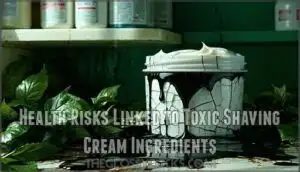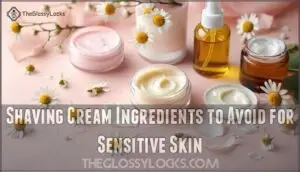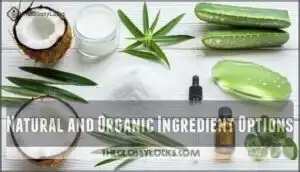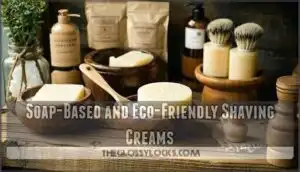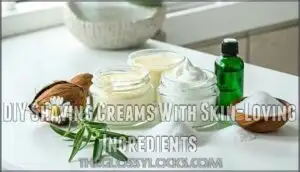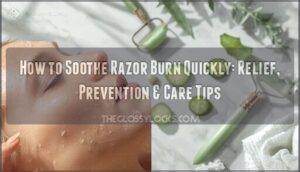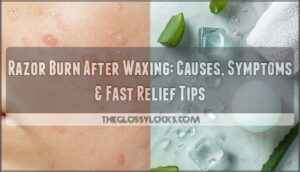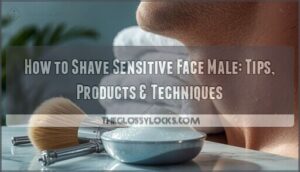This site is supported by our readers. We may earn a commission, at no cost to you, if you purchase through links.
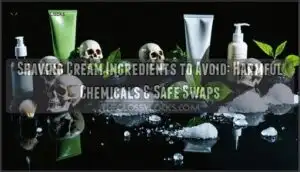 Your skin absorbs roughly 60% of what you apply to it—a fact that transforms your daily shave from a mundane ritual into a direct chemical exposure. Most conventional shaving creams contain a cocktail of synthetic compounds that can irritate your skin, disrupt your hormones, and accumulate in your body over time.
Your skin absorbs roughly 60% of what you apply to it—a fact that transforms your daily shave from a mundane ritual into a direct chemical exposure. Most conventional shaving creams contain a cocktail of synthetic compounds that can irritate your skin, disrupt your hormones, and accumulate in your body over time.
These ingredients hide behind technical names on labels, making it nearly impossible to identify which products are actually safe. The chemicals that create that luxurious foam and pleasant scent often come with hidden costs to your health.
Understanding which shaving cream ingredients to avoid enables you to protect your skin‘s natural barrier while reducing your exposure to potentially harmful substances that serve no benefit beyond shelf appeal.
Table Of Contents
- Key Takeaways
- Harmful Chemicals Commonly Found in Shaving Cream
- Health Risks Linked to Toxic Shaving Cream Ingredients
- Shaving Cream Ingredients to Avoid for Sensitive Skin
- Safer Alternatives to Conventional Shaving Creams
- Tips for a Healthier, More Comfortable Shaving Routine
- Frequently Asked Questions (FAQs)
- Are there harmful chemicals in shaving cream?
- What is the safest shaving cream to use?
- What is the best thing to use instead of shaving cream?
- What chemicals are in shaving cream?
- How do I read shaving cream ingredient labels?
- Can shaving cream ingredients cause hair loss?
- Are expensive shaving creams actually safer products?
- What certifications indicate truly clean shaving cream?
- Do mens and womens shaving creams differ chemically?
- Conclusion
Key Takeaways
- Your skin absorbs about 60% of what you apply, and most conventional shaving creams contain synthetic compounds like TEA, DEA, parabens, sulfates, and synthetic fragrances that can irritate skin, disrupt hormones, and accumulate in your body with long-term exposure.
- These chemicals often hide behind vague labels like "parfum" (which can represent up to 300 individual compounds) or technical names, making it difficult to identify safe products without careful ingredient scrutiny.
- Safer alternatives include natural plant-based oils like coconut or jojoba, soap-based formulas with minimal ingredients, or DIY recipes using recognizable components—all of which protect your skin barrier without the chemical burden.
- Price doesn’t guarantee safety, and expensive products often contain the same toxic ingredients as budget options, so focus on ingredient transparency, third-party certifications, and avoiding specific harmful compounds rather than relying on cost or marketing claims.
Harmful Chemicals Commonly Found in Shaving Cream
Many shaving creams contain ingredients that can harm your skin or pose broader health risks. Understanding what’s in your shaving cream helps you make safer choices for your daily routine. Here’s what you need to watch out for.
Nitrosamine-Forming Compounds (TEA, DEA, MEA)
TEA, DEA, and MEA are secondary amines that react with nitrites to form N-nitrosamines—carcinogenic compounds linked to serious health hazards. When you apply shaving cream containing these chemicals, your skin absorbs them, enabling nitrosamine formation that poses cancer risks.
European regulations cap nitrosamine content at 50 μg/kg, yet older products often exceed this limit. Studies found nitrosamines in over 40% of tested cosmetics, with concentrations sometimes reaching dangerous levels.
Some shaving creams also contain harmful ingredients like parfum.
Synthetic Fragrances and Parfum
When you scan your shaving cream label and see “fragrance” or “parfum,” you’re looking at a regulatory gap that hides up to 300 individual chemicals. Over 95% of scented products use these synthetic fragrances, which contain phthalates and synthetic musks linked to endocrine disruption and reproductive toxicity.
Fragrance or parfum on labels legally conceals up to 300 chemicals, including endocrine disruptors found in over 95% of scented products
Studies show nearly all Americans carry phthalate metabolites in their urine from everyday exposure. The allergenic potential is significant—up to 12.8% of tested individuals react to fragrance allergens, with men who shave facing higher risks due to skin microtrauma increasing penetration of these harmful chemicals.
These fragrances also have significant environmental impacts due to their composition.
Sulfates and Harsh Foaming Agents (SLS, SLES)
That luxurious lather you love might strip away more than just stubble—Sodium Lauryl Sulfate (SLS) and Sodium Laureth Sulfate (SLES) are harsh detergents that remove your skin’s protective oil barrier with every shave. These sulfates create microtears in your skin barrier, leading to:
- Chronic dryness and flaking
- Increased sulfate sensitivity over time
- Impaired hair follicle function
- Enhanced penetration of other harmful shaving cream ingredients
- Persistent irritation requiring SLS alternatives
Your compromised skin barrier can’t defend against bacteria or retain moisture effectively. If you experience burning or tightness after shaving, SLES concerns are valid—these foaming agents prioritize lather over skin health.
Petroleum-Derived Ingredients (PEGs, Mineral Oils)
Your skin absorbs petroleum-based compounds like Polyethylene Glycol (PEG) and mineral oils faster than you’d expect, and these ingredients bring contamination risks that extend far beyond the bathroom mirror. During petrochemical production, PEG contamination with ethylene oxide—a known carcinogen—frequently occurs. Mineral oil risks include pore-clogging that traps bacteria and prevents natural skin respiration.
These harmful chemicals in cosmetics also carry a significant environmental impact through production waste and water pollution. Sustainable alternatives exist that don’t compromise your skin’s integrity or the planet’s health.
Preservatives and Parabens
Parabens—commonly listed as methylparaben, propylparaben, or butylparaben—preserve your shaving cream’s shelf life while disrupting your body’s hormone balance in ways scientists are still measuring. These chemical compounds mimic estrogen, contributing to endocrine disruption that affects reproductive health. Regulatory oversight remains inconsistent across regions, leaving ingredient safety decisions largely in your hands.
Watch for these parabens in shaving cream ingredients:
- Methylparaben
- Propylparaben
- Butylparaben
- Ethylparaben
- Isobutylparaben
Paraben alternatives like potassium sorbate and sodium benzoate offer preservation without hormonal interference, though preservative sensitivity varies by individual skin type.
Artificial Dyes and Coloring Agents
Why does your shaving cream look like blue raspberry candy when its only job is protecting your skin from a sharp blade? Synthetic colors like FD&C Blue No. 1 and Yellow No. 5 serve no function beyond aesthetics, yet they trigger dye allergies and skin sensitivity in susceptible individuals. These colorant sources carry varying toxicity levels, with dye regulations differing globally—leaving harmful chemicals in shaving cream ingredients that create skin irritation and function as skin allergens without adding protective value.
| Common Synthetic Dyes | Associated Skin Reactions |
|---|---|
| FD&C Blue No. 1 | Contact dermatitis, hives |
| FD&C Yellow No. 5 | Allergic reactions, itching |
| FD&C Red No. 40 | Skin sensitivity, inflammation |
| D&C Red No. 33 | Irritation, eczema flare-ups |
| CI 42090 (Blue dye) | Dermatitis, redness |
Health Risks Linked to Toxic Shaving Cream Ingredients
When you apply products to your skin every day, you’re doing more than just preparing for a shave. The chemicals in many conventional shaving creams can trigger reactions that range from minor irritation to serious long-term health concerns.
Understanding these risks helps you make informed choices about what you put on your body.
Skin Irritation and Allergic Reactions
Contact dermatitis, razor burn, and itchy red bumps aren’t just annoying side effects—they’re your skin’s way of waving a red flag at the chemicals you’re rubbing into it every time you shave. These reactions signal an inflammatory response to potential skin irritants like synthetic fragrances and sulfates.
Redness and rash, itchiness and burning—these symptoms point to skin allergens triggering contact dermatitis or outright allergic reactions that demand sensitivity testing and ingredient awareness.
Hormone Disruption and Carcinogenic Risks
Some harmful chemicals in shaving products act as endocrine disruptors, mimicking hormones like estrogen and testosterone. Parabens and phthalates—often hidden under "parfum"—have been detected in breast cancer tissues and linked to reproductive harm through cumulative exposure.
Nitrosamine formation from TEA, DEA, and MEA creates potent carcinogens, with cocamide DEA classified as possibly carcinogenic by international agencies.
Chemical mixtures increase these risks through synergistic effects, yet regulatory challenges and ingredient transparency gaps leave you exposed to these harmful chemicals daily.
Respiratory and Systemic Effects
When you breathe in aerosol mist from shaving foam or accidentally absorb certain chemicals through your skin, you’re facing inhalation hazards and systemic exposure that go beyond surface irritation. These toxic chemicals can enter your bloodstream and affect organs far from where you first applied the product.
- Propellants and isopentane trigger nose and throat irritation, headaches, and dizziness—especially in poorly ventilated bathrooms.
- TEA, DEA, and glycols absorb through your skin and may stress your kidneys or disrupt blood chemistry with repeated use.
- Fragrance compounds and BHT have been linked to neurological symptoms and a 2-3 times higher risk of asthma-like reactions in chronic users.
Long-Term Effects on Skin Health
Day after day, shaving over the same patch of skin—without thinking about what’s in that can—sets the stage for changes you mightn’t notice until years down the road. Cumulative chemical exposure from harmful chemicals weakens your barrier function, triggering chronic inflammation that accelerates premature skin aging.
These chemical compounds worsen skin irritation and allergic reactions while gradually increasing skin cancer risk. The adverse effects of chemicals on skin health compound silently, reshaping your complexion in ways that become harder to reverse over time.
Shaving Cream Ingredients to Avoid for Sensitive Skin
If you have sensitive skin, certain ingredients can turn a simple shave into a painful experience. The wrong formula can trigger redness, dryness, or even long-term damage to your skin’s protective barrier.
Let’s look at the specific compounds you should avoid to keep your skin calm and healthy.
Drying Alcohols and Solvents
If you’ve ever felt a tight, almost papery sensation on your face after shaving, drying alcohols might be the culprit hiding in your shaving cream. These solvents disrupt your skin barrier, leading to significant dehydration effects. Alcohol absorption strips away natural oils, leaving your skin vulnerable to irritation and flaking.
Common drying alcohols to avoid include:
- Isopropyl alcohol – causes severe solvent irritation and moisture loss
- Ethanol and SD alcohol – chemical compounds in shaving products that weaken protection
- Denatured alcohol – among the most harmful ingredients with potential health hazards
Look for safe solvents like cetyl or stearyl alcohol instead.
Butylated Hydroxytoluene (BHT)
Butylated Hydroxytoluene (BHT) shows up in shaving creams as a preservative, but this synthetic antioxidant ranks as the 37th most toxic chemical according to federal assessments—not exactly something you want sitting on your freshly shaved skin. BHT exposure raises health risks including skin irritation and potential systemic effects.
Current BHT research links these chemical compounds in shaving products to allergic reactions in sensitive individuals. BHT regulation remains minimal despite documented BHT toxicity.
Look for BHT alternatives like vitamin E or rosemary extract in shaving cream ingredients instead.
Palmitic Acid and Dermatitis Triggers
Palmitic acid, a saturated fatty acid derived from palm oil or animal fats, appears in shaving creams at 1–6% concentration—yet this common emollient can trigger dermatitis in people with sensitive or compromised skin barriers. Your skin’s keratinocytes respond to palmitic acid by releasing inflammatory signals that disrupt your skin barrier and provoke an immune response, potentially leading to allergic sensitization over time.
Watch for these potential skin irritants and adverse effects of ingredients:
- Contact dermatitis flare-ups, especially when palmitic acid combines with alcohols or surfactants
- Increased scratching behaviors and itch intensity
- Redness, scaling, and barrier dysfunction
- Enhanced inflammatory pathways that make future reactions more likely
Glycols and Their Impact
Glycols—a family of petroleum-derived solvents like propylene glycol and butylene glycol—show up in shaving creams as humectants and viscosity agents. However, they can strip your skin’s protective barrier, leading to dryness, rashes, and irritation that worsen with repeated use. High concentrations increase glycol absorption through compromised skin, raising concerns about blood and kidney disorders in vulnerable populations.
| Glycol Type | Common Skin Issues |
|---|---|
| Propylene Glycol | Skin rashes, dermatitis |
| Butylene Glycol | Dryness, barrier disruption |
| Polyethylene Glycol (PEG) | Irritation, contamination risk |
| Dipropylene Glycol | Contact sensitivity |
| Ethoxydiglycol | Allergic reactions |
Look for glycol alternatives like vegetable glycerin or plant-derived ingredients that maintain moisture without compromising cosmetic product safety. While safe glycols exist, many skin care products labeled as "gentle" still contain problematic variants.
Safer Alternatives to Conventional Shaving Creams
You don’t have to settle for products loaded with questionable chemicals. Switching to safer shaving products protects your skin without sacrificing a close, comfortable shave.
Here are four practical alternatives that work with your skin instead of against it.
Natural and Organic Ingredient Options
When you choose natural ingredients in shaving cream, you’re selecting plant-based oils like coconut and jojoba that protect your skin barrier rather than strip it away. These skin-loving alternatives often carry organic certifications, ensuring sustainable sourcing without synthetic additives.
Market trends show a growing demand for all-natural formulas featuring essential oils and botanical extracts. Many users now create DIY recipes using simple, recognizable ingredients that deliver smooth shaves without the chemical burden.
Soap-Based and Eco-Friendly Shaving Creams
Traditional soap-based shaving creams offer a gentler, time-tested approach that skips synthetic chemicals while delivering the protective lather your skin needs. These eco-friendly options use simple soap ingredients, often packaged in recyclable containers that reduce environmental impact.
You’ll find shaving soap benefits include sustainability, minimal packaging waste, and formulas free from harsh additives—making them excellent shaving cream alternatives for health-conscious users.
DIY Shaving Creams With Skin-Loving Ingredients
Making your own shaving cream at home gives you complete control over what touches your skin—and the basic recipe takes just minutes to prepare. You can select natural ingredients that work with your skin type, avoid harsh chemicals entirely, and customize formulas with plant-based oils or herbal infusions that deliver real benefits.
DIY shaving cream essentials:
- Base ingredients – Shea butter, coconut oil, and baking soda create protective lather
- Skin-soothing additions – Aloe vera gel or chamomile tea calm irritation
- Essential oils – Tea tree or lavender add antimicrobial properties
- Storage method – Keep in sterilized glass jars; refrigerate if using fresh ingredients
- Shelf life – Most recipes last 2-3 months when stored properly
Using Oils (Coconut, Jojoba, Aloe Vera)
Coconut oil, jojoba oil, and aloe vera act as minimalist shaving solutions. Each one lubricates your razor while delivering moisture and protection without a single synthetic additive.
Apply a thin layer of coconut or jojoba directly to damp skin, or blend all natural oils with aloe for extra slip.
These ingredients suit most skin types and store well in cool, dark spaces.
Tips for a Healthier, More Comfortable Shaving Routine
Switching to safer products is only part of the equation. Your shaving technique and routine play an equally important role in protecting your skin from irritation, microtears, and long-term damage.
Let’s walk through the key steps that support healthier skin before, during, and after each shave.
Pre-Shave Skin Preparation Techniques
Preparing your skin before you shave is like laying the foundation for a house—skip this step, and you’ll feel the consequences with every stroke of the razor. Start by soaking your skin in warm water for at least ten minutes to soften hair and open pores.
Follow with gentle exfoliation methods using a loofah to remove dead skin cells that cause ingrown hairs.
Apply pre-shave oils or quality shaving gels containing skin-friendly ingredients to create a protective barrier that aids your skin health throughout the shaving process.
Choosing The Right Razor and Tools
Your razor is your most trusted ally in this process, and selecting one with sharp, clean blades makes all the difference between smooth skin and a battlefield of nicks and irritation. Choose a razor type with quality blade material—stainless steel prevents rust and maintains sharpness longer.
Grip design matters when using it on curved areas, while proper tool maintenance extends blade life and protects your skin from bacterial buildup, regardless of budget considerations.
Post-Shave Care and Moisturizing
Once you’ve finished shaving, your skin is more vulnerable than you might think—stripped of its protective oils and begging for the right kind of care. Here’s what your skin needs:
- Cold water rinse closes pores and prevents bacteria from settling in
- Moisturizer ingredients like aloe vera or chamomile soothe skin irritation without harsh chemical composition
- Sun protection shields freshly shaved skin from UV damage
Store your razor properly to prevent ingrown hairs next time.
Improving Your Routine With Ingredient Awareness
Reading labels isn’t just about avoiding irritation—it’s about taking control of what you allow to touch your largest organ day after day. Label reading allows you to make informed choices about skin care product ingredients and chemicals.
Look for brand transparency and ethical sourcing when selecting shaving cream. Sustainable shaving starts with understanding what’s inside the bottle, protecting your skin from unnecessary irritation.
Frequently Asked Questions (FAQs)
Are there harmful chemicals in shaving cream?
Yes, many shaving creams contain harmful chemicals. Common toxic ingredients include nitrosamine-forming compounds, synthetic fragrances, sulfates, and petroleum-derived substances.
These chemicals can cause skin irritation, hormone disruption, and other health risks through chemical absorption.
What is the safest shaving cream to use?
The safest shaving cream formulas contain minimal, hypoallergenic ingredients with clear transparency.
Look for dermatologist recommendations and user reviews that highlight natural ingredients like aloe vera, shea butter, and coconut oil without harsh chemicals or synthetic fragrances.
What is the best thing to use instead of shaving cream?
Natural plant-based oils like coconut, jojoba, or aloe vera gel work as excellent DIY alternatives.
Soap options with skin-loving natural ingredients provide lubrication without harsh chemicals, while some prefer using just a sharp razor with warm water.
What chemicals are in shaving cream?
Shaving cream formulation usually includes water, lubricants like glycerin, surfactants for lather, emollients, preservatives, and fragrances.
Consumer awareness about chemical composition of shaving cream matters because toxic ingredients and health risks vary widely between products, despite limited ingredient regulation and inconsistent label transparency.
How do I read shaving cream ingredient labels?
Decoding ingredients starts with the label itself—look for substances listed in descending order by concentration.
Spotting red flags means identifying allergens and toxic ingredients early, while understanding functions helps you evaluate each chemical’s purpose and health risks.
Can shaving cream ingredients cause hair loss?
Certain chemicals in shaving cream can disrupt hair growth cycles. Sulfates strip natural oils, weakening follicles.
Hormone-disrupting compounds like TEA may indirectly affect scalp sensitivity and follicle health, though direct links to significant hair loss remain limited in research.
Are expensive shaving creams actually safer products?
Price doesn’t guarantee safety. Many expensive shaving creams contain the same toxic ingredients as budget options. Marketing claims often overshadow chemical composition.
Look for ingredient transparency and independent testing rather than relying on cost. Natural ingredients in shaving cream matter more than price tags when avoiding health risks.
What certifications indicate truly clean shaving cream?
Look for stamps from trusted certification bodies like USDA Organic, EWG Verified, or Leaping Bunny—these signal ingredient transparency, third-party verification, and cruelty-free status while confirming sustainable sourcing and natural ingredients in shaving creams.
Do mens and womens shaving creams differ chemically?
Most shaving creams share the same chemical composition and ingredient concentration regardless of gender labeling. Marketing tactics rely on fragrance differences and packaging rather than meaningful pH levels or formulations. Your skin sensitivity matters more than the label.
Conclusion
An ounce of prevention beats a pound of cure—especially regarding what touches your skin daily. Your awareness of shaving cream ingredients to avoid transforms you from a passive consumer into an informed guardian of your health.
The chemicals that create foam and fragrance don’t deserve space in your routine when natural alternatives deliver excellent results without compromise.
Read labels carefully, question suspicious ingredients, and remember that your skin’s barrier deserves the same scrutiny you’d apply to anything you’d ingest.

